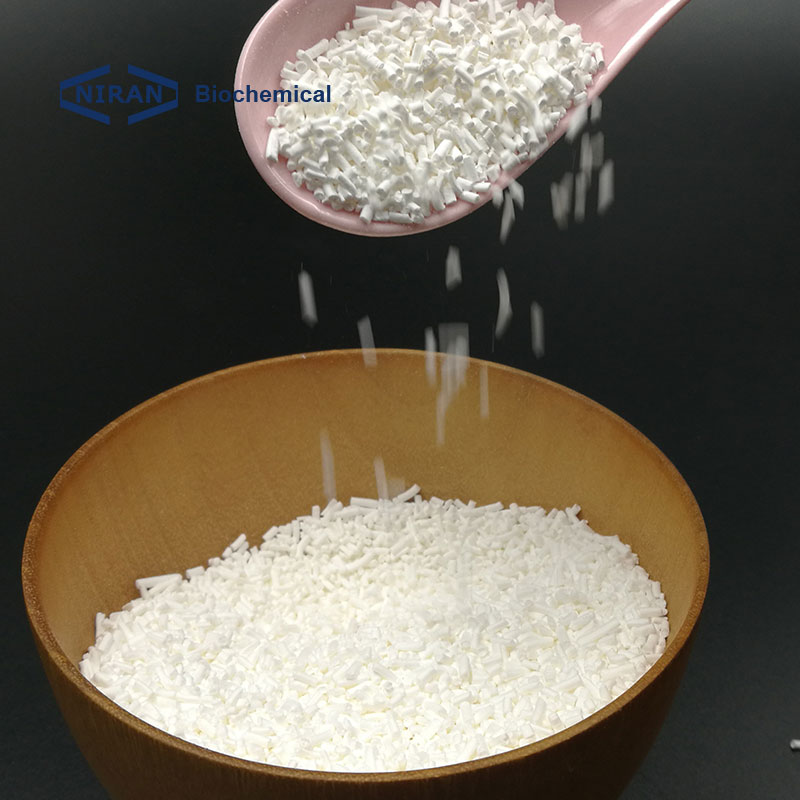Potassium Sorbate – potassium salt of sorbic acid (naturally occurring polyunsaturated fat). It’s used as a preservative.

SORBIC ACID K
SALT;potassiumsalt,(e,e)-4-hexadienoicacid;potassiumsalt,(e,e)-sorbicaci;potassiumsorbate(e);(E,E)-hexadienoic acid, potassium salt;2,4-potassium hexadienoic acid;potassium (E,E)-hexa-2,4-dienoate;POTASSIUM SORBATE, GRAN FCC/ USP/NF
Product Categories: Food additive;FOOD ADDITIVES;Food & Feed ADDITIVES;Classes of Metal Compounds;K (Potassium) Compounds (excluding simple potassium salts);Typical Metal Compounds
Overview:Potassium sorbate is petitioned for use in organic livestock production as mold inhibitor[ Sorbic acid was first discovered in the Mountain Ash Tree (Sorbus aucuparia or Sorbus americana). Today most potassium sorbate is made synthetically. Potassium sorbate is a naturally occurring unsaturated fatty acid and is completely safe with regard to health and has the lowest allergenic potential of all food preservatives. Potassium sorbate was also petitioned for use in liquid livestock medications primarily aloe vera juice as a substitute for antibiotics and other various hormones.
The use of chemical food preservatives, except for salts, sugars, spices, vinegar, etc., was not very widespread until the last 200 years. Progress in the development of food preservatives has not been steady. With a view to developing more effective, simpler, and less expensive means of food preservation, many chemicals having strong antimicrobial properties were initially utilized for food preservation but were subsequently abandoned when their undesirable physiological and biochemical properties were discovered. For example, boric acid, salicyclic acid, creosote, and formaldehyde, which were utilized as preservatives in foods during the 19th century, are no longer used. On the other hand, sorbic acid (SA), benzoic acid, p-hydroxy benzoic acid esters, and sulfur dioxide have proved very useful in various food preservation applications and their use has been officially permitted in almost all countries of the world.
When dissolved in water, potassium sorbate ionizes to form sorbic acid which is effective against yeasts, molds, and select bacteria, and is widely used at 250 ppm to 1000 ppm levels in cheeses, dips, yogurt, sour cream, bread, cakes, pies and fillings, baking mixes, doughs, icings, fudges, toppings, beverages, margarine, salads, fermented and acidified vegetables, olives, fruit products, dressings, smoked and salted fish, confections and mayonnaise. Therefore, it is generally used as a powerful food preservative.

Antimicrobial properties of sorbic acid were discovered independently in 1939 and 1940 by Muller and Gooding in Germany and the USA, respectively. After this discovery, sorbic acid and its salts were tested and used in a variety of consumer products for inhibition of yeast and molds and certain bacteria. But its use as a food preservative had to wait until 1950 when commercial production commenced. Initially sorbates were known to be effective inhibitors of yeast and molds, and less so of bacteria. In 1974 Tompkin et al.reported that addition of 0.1 % potassium sorbate to uncured sausages delayed the growth of Salmonella spp. and Staphylococcus aureus as well as growth and toxin production by Clostridium botulinum. Following these findings, extensive studies were undertaken on the potential use of sorbic acid or its salts as antibotulinal agents and preservatives in various types of meats and meat products. These compounds were tested in combination with low levels of sodium nitrite for the preservation of cured meats and the reduction of potentially carcinogenic nitrosamine in products such as bacon. Most recently sorbic acid has played a very important role in the development of intermediate-moisture foods. The water activity of these foods is low enough to control the growth of bacteria but not growth of yeast and molds; therefore, sorbic acid is used as a very effective antimycotic agent in these products. Sorbic acid and its salts are also being used as one of the various “hurdles” employed to control microbial growth in intermediate moisture foods.

Unfortunately, grain and feed provides an ideal environment for molds to proliferate. Raw materials or feeds in bulk storage are rich sources of energy, proteins and moisture and, thus, are highly conducive to mold growth. Potassium sorbate is the potassium salt of sorbic acid, and is much more soluble in water than the acid. Potassium sorbate will produce sorbic acid once it is dissolved in water and is the most widely used food preservative in the world. It is effective up to pH 6.5 but effectiveness increases as the pH decreases. Potassium sorbate has about 74% of the antimicrobial activity of the sorbic acid, thus requiring higher concentrations to obtain the same results that pure sorbic acid provides. Potassium sorbate is effective against yeasts, molds, and select bacteria, and is widely used at 0.025 to 0.10 % levels in cheeses, dips, yogurt, sour cream, bread, cakes, pies and fillings, baking mixes, doughs, icings, fudges, toppings, beverages, margarine, salads, fermented and acidified vegetables, olives, fruit products, dressings, smoked and salted fish, confections and mayonnaise. Maximum level allowable by law is 0.1%. It is important to know that the addition of sodium benzoate and/or potassium sorbate to a food product will raise the pH by approximately 0.1 to 0.5 pH units depending on the amount, pH, and type of product. Additional adjustment of the pH might be needed to keep the pH at a safe level.
